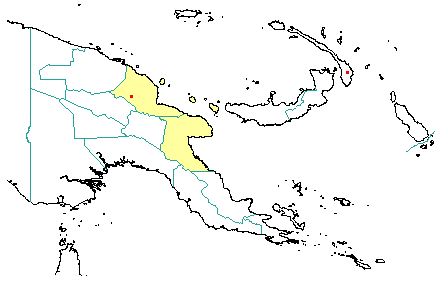
in PNGplants database
PNGTreesKey – Vitex quinata (Lour.) F.N.Will. |
Barry Conn (NSW) & Kipiro Damas (LAE).
Guide to trees of Papua New Guinea
Copyright held by the authors, National Herbarium of New South Wales, and Papua New Guinea National Herbarium
Bull. Herb. Boiss., Series 2 Vol. 5: 431
Family: Lamiaceae
Dicotyledon
Timber Group: Occasional timber species
Field Characters: Small sub-canopy tree or Large canopy tree (up to 30 m high); Bole cylindrical (30-60 cm diam., rarely larger); crooked (bole 8-10 m long); buttresses buttresses present (buttresses up to 1 m high); spines spines absent; aerial roots aerial roots absent; stilt roots stilt roots absent; Bark pale brown or grey, rough, scaly or flaky or slightly pustular, lenticels irregular; Subrhytidome (under-bark) yellow; less than 25 mm thick; bark blaze consisting of one layer; faintly to non-aromatic; pleasant; outer blaze pale brown or yellow (pale (straw-coloured), speckled, granular with splinters; inner blaze yellow (pale (straw-coloured) or pale brown, speckled, granular with splinters; bark exudate (sap) present, colourless, not readily flowing (spotty), colour changing on exposure to air, to greenish black, not sticky; terminal buds not enclosed by leaves.
Indumentum: Complex hairs absent; stinging hairs absent; mature twig indumentum (hairs) present, hairs sparse.
Leaves: Leaves spaced along branches, opposite (in pairs, opposite one another on the branchlet), compound (a leaf made up from two or more leaflets); petiole present, not winged, attached to base of leaf blade, not swollen; leaves palmate (with more than three leaflets attached at one point to the stalk); petiolule swollen (at base); leaves broadest above middle, 7.5-18.0 cm, 4.0-7.0 cm, leaflets arranged from one point, asymmetric; venation pinnate, secondary veins open, prominent, intramarginal veins absent; leaves lower surface pale green, upper surface dark green, indumentum (hairs) absent; absent; domatia absent; stipules absent.
Flowers: Inflorescence terminal, flowers on a branched axis, cones absent; flowers bisexual, stalked, flowers with one plane of symmetry, 5.0-8.0 mm long, diameter small (up to10 mm diam.) (4-5 mm diam.); perianth present, with distinct sepals and petals whorls, inner perianth pale purple, white, or blue; 5, some or partly joined; stamens 4, present, free of each other, joined to the perianth; ovary superior, carpels joined (when more than one), locules 4; styles solitary, 1.
Fruits: Infrutescence arranged on branched axis, fruit not spiny, fleshy, simple, indehiscent, drupe; seeds 4, not winged.
Distribution: Madang or Morobe.
 | Botanical records in PNGplants database |
Notes: Notes This species is sometimes difficult to distinguish from Viticipremna philippinensis which occurs in the southern parts of the Western Province. However, the 4-lobed corolla of the latter species readily separate it from Vitex quinata which has a 5-lobed corolla. Refer to notes under Viticipremna novaepommeraniae for a discussion on how to distinguish this latter species from Vitex quinata.
Vitex was previously classified as part of the Verbenaceae. It is now regarded as part of the Lamiaceae subfamily Viticoideae.